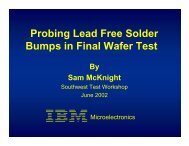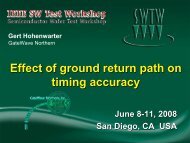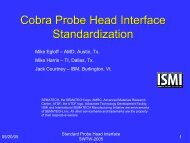Probe-tip Clean on Demand - Semiconductor Wafer Test Workshop
Probe-tip Clean on Demand - Semiconductor Wafer Test Workshop
Probe-tip Clean on Demand - Semiconductor Wafer Test Workshop
Create successful ePaper yourself
Turn your PDF publications into a flip-book with our unique Google optimized e-Paper software.
Rob Marcelis<br />
Salland Engineering<br />
<str<strong>on</strong>g>Probe</str<strong>on</strong>g>-Tip <str<strong>on</strong>g>Clean</str<strong>on</strong>g> On <strong>Demand</strong><br />
June 8-11, 8<br />
2008<br />
San Diego, CA USA
Introducti<strong>on</strong><br />
• Today <str<strong>on</strong>g>Probe</str<strong>on</strong>g>-<str<strong>on</strong>g>tip</str<strong>on</strong>g> clean settings are static<br />
• <str<strong>on</strong>g>Clean</str<strong>on</strong>g> interval is every x-dies or x-wafers<br />
• How to determine the right settings?<br />
• Not enough cleaning can cause yield loss!<br />
• To often cleaning will “eat-up” your <str<strong>on</strong>g>tip</str<strong>on</strong>g>s<br />
– When abrasive scrub is being used<br />
– Above all; it will cost time!<br />
• This presentati<strong>on</strong> is not about the cleanmethod<br />
but the clean moment!<br />
June 8 to 11, 2008<br />
IEEE SW <strong>Test</strong> <strong>Workshop</strong> 2
Background<br />
• Case study for <strong>on</strong>e of our customers;<br />
– Customer currently uses clean interval every 100 die<br />
(worse-case setting)<br />
– Customer is testing the most wafers (80%) at<br />
elevated temperatures<br />
– As so<strong>on</strong> as probe-<str<strong>on</strong>g>tip</str<strong>on</strong>g>s “leave” the wafer, a probe-<str<strong>on</strong>g>tip</str<strong>on</strong>g><br />
soak is required before proceeding<br />
– <str<strong>on</strong>g>Clean</str<strong>on</strong>g> cycle takes ca. 5 sec<br />
– Soak cycle takes 120 sec (worse case setting)<br />
– Total cycle 125 sec!<br />
June 8 to 11, 2008<br />
IEEE SW <strong>Test</strong> <strong>Workshop</strong> 3
Background<br />
– Can we detect when cleaning should be<br />
d<strong>on</strong>e?<br />
• Wait until fails show up is not the way!<br />
– Could we m<strong>on</strong>itor the real-time parametric<br />
data and resp<strong>on</strong>d if a trend is detected?<br />
• Trend should be; values raise or fall in c<strong>on</strong>secutive<br />
order<br />
• A threshold value should be set to initiate the clean<br />
moment<br />
June 8 to 11, 2008<br />
IEEE SW <strong>Test</strong> <strong>Workshop</strong> 4
Objectives / Goals<br />
• To clean <strong>on</strong>ly then when it is necessary<br />
• Every reducti<strong>on</strong> of a clean cycle will also<br />
reduce a “soak” cycle!<br />
• The clean <strong>on</strong> demand should lead into<br />
total wafer process time reducti<strong>on</strong>.<br />
• Save probe-card life-time (scrub)<br />
June 8 to 11, 2008<br />
IEEE SW <strong>Test</strong> <strong>Workshop</strong> 5
Methods / Materials / Procedures<br />
From SE-PROBE to a Dynamic <strong>Test</strong>-cell C<strong>on</strong>troller<br />
TESTER<br />
SE-PROBE DTC PROBER /<br />
HANDLER<br />
OEE Module<br />
More to come!<br />
RTDana Module<br />
Datalog Module<br />
Daem<strong>on</strong><br />
PAT Module<br />
Trend Module<br />
Net<br />
June 8 to 11, 2008<br />
IEEE SW <strong>Test</strong> <strong>Workshop</strong> 6
Methods / Materials / Procedures<br />
• When to clean?<br />
– It does not matter how many needles you<br />
have, if <strong>on</strong>ly <strong>on</strong>e requires cleaning; You have<br />
to clean the entire probe card!<br />
• On almost every “pin” a c<strong>on</strong>tact-test is<br />
performed at the start of each test-cycle<br />
– Should we m<strong>on</strong>itor all those tests and if <strong>on</strong>e of<br />
them shows a c<strong>on</strong>secutive increase of value;<br />
perform a clean?<br />
June 8 to 11, 2008<br />
IEEE SW <strong>Test</strong> <strong>Workshop</strong> 7
Methods / Materials / Procedures<br />
• Still remains those “pins” where no real<br />
c<strong>on</strong>tact test could be performed!<br />
• We also know that some higher current<br />
carrying pins show Frittering, which could<br />
“burn” the dirt.<br />
• Increase of C-res shows at “most c<strong>on</strong>tact<br />
sensitive test”<br />
• So what would be the best suitable<br />
method?<br />
June 8 to 11, 2008<br />
IEEE SW <strong>Test</strong> <strong>Workshop</strong> 8
Methods / Materials / Procedures<br />
Most sensitive pin<br />
DUT<br />
Cres increase during probing<br />
Some pins may use signals<br />
from a number of other pins,<br />
Result in an add-up of all Cres values<br />
June 8 to 11, 2008<br />
IEEE SW <strong>Test</strong> <strong>Workshop</strong> 9
Methods / Materials / Procedures<br />
• Almost every device has got a most sensitive pin<br />
for “good-c<strong>on</strong>tact”<br />
• How to detect this pin?<br />
• Start with a “good” set-up <strong>on</strong> the prober<br />
– Acceptable probe marks<br />
– Good test results (bin 1 part)<br />
• The DTC will start the first fail algorithm;<br />
– The Z-stage (chuck) is lowered a small steps<br />
– <strong>Test</strong> is repeated<br />
– This c<strong>on</strong>tinues until the first fail occurs<br />
June 8 to 11, 2008<br />
IEEE SW <strong>Test</strong> <strong>Workshop</strong> 10
Methods / Materials / Procedures<br />
<strong>Wafer</strong><br />
Chuck<br />
Z-up<br />
Z- first fail<br />
June 8 to 11, 2008<br />
IEEE SW <strong>Test</strong> <strong>Workshop</strong> 11
Methods / Materials / Procedures<br />
• For the first test generating a fail;<br />
– test-number is stored.<br />
• This “search” for the first failing test is now<br />
repeated a few times <strong>on</strong> the same die and a<br />
check is performed <strong>on</strong> repeatability of the<br />
results. The found test(s) is(are) classified as the<br />
“most c<strong>on</strong>tact sensitive test(s)”<br />
• The next step is to repeat the “search” <strong>on</strong> a few<br />
more die locati<strong>on</strong>s.<br />
June 8 to 11, 2008<br />
IEEE SW <strong>Test</strong> <strong>Workshop</strong> 12
Methods / Materials / Procedures<br />
• Start with<br />
normal overtravel<br />
• Decreased<br />
over-travel<br />
with small<br />
steps<br />
• At black line,<br />
back to<br />
starting<br />
value<br />
June 8 to 11, 2008<br />
IEEE SW <strong>Test</strong> <strong>Workshop</strong> 13
Methods / Materials / Procedures<br />
• Alternative method to detect c<strong>on</strong>tact sensitive<br />
tests:<br />
– <strong>Test</strong> wafer without cleaning<br />
– Analyze tester datalog file<br />
– Look for those tests which show increase trend after a<br />
while<br />
• Even when cleaning is used at static setting;<br />
– It could be visible to see the value “resetting” after<br />
each clean<br />
June 8 to 11, 2008<br />
IEEE SW <strong>Test</strong> <strong>Workshop</strong> 14
Real wafer data with clean every<br />
100 die<br />
With 100 die clean frequency, low test value does<br />
not go below 2.93<br />
100 die clean interval<br />
June 8 to 11, 2008<br />
IEEE SW <strong>Test</strong> <strong>Workshop</strong> 15
Real data with clean every 100<br />
die<br />
• This test shows c<strong>on</strong>tact resistance<br />
sensitivity<br />
• After each clean the value “jumps” back<br />
• Clearly the 100 die clean interval is<br />
recognizable<br />
– In fact more tests did show this behavior<br />
• Values stay well above the minimum test<br />
limit.<br />
• It is a save setting! But too often?<br />
June 8 to 11, 2008<br />
IEEE SW <strong>Test</strong> <strong>Workshop</strong> 16
<strong>Wafer</strong> run without clean to 680 TD’s<br />
• First<br />
reject<br />
after ca<br />
500 die<br />
(red marker)<br />
• <str<strong>on</strong>g>Clean</str<strong>on</strong>g> at<br />
680 th die<br />
2.93 value from static clean<br />
June 8 to 11, 2008<br />
IEEE SW <strong>Test</strong> <strong>Workshop</strong> 17
Methods / Materials / Procedures<br />
• After analyzing the gathered data; the clean<br />
recipe can be generated;<br />
– <strong>Test</strong> number(s) to m<strong>on</strong>itor<br />
– Per test number the threshold (should be set before<br />
real failures occur)<br />
– Minimum clean interval to get rid of the debris (even if<br />
this does not harm the test results)<br />
– <str<strong>on</strong>g>Clean</str<strong>on</strong>g> probes at each wafer change<br />
• <str<strong>on</strong>g>Clean</str<strong>on</strong>g>ing <strong>on</strong> demand now takes place when the<br />
selected test(s) show c<strong>on</strong>secutive<br />
increase/decrease in value plus go trough the<br />
threshold level.<br />
June 8 to 11, 2008<br />
IEEE SW <strong>Test</strong> <strong>Workshop</strong> 18
<strong>Test</strong> number 10634.0047<br />
• <strong>Test</strong> data generated <strong>on</strong> wafer without <str<strong>on</strong>g>tip</str<strong>on</strong>g> clean for<br />
1 st 650 die.<br />
• <strong>Test</strong> result show a overall down-ward trend<br />
• Around 500 die the 1 st reject red circle<br />
• Need clean before 1 st reject<br />
• Proposal for clean recipe;<br />
– Low threshold at 2.95<br />
– C<strong>on</strong>secutive number (trend width) at 5<br />
• Then no clean until orange marked area (380 die)<br />
– Brings almost 75% saving in clean cycles<br />
• Green area shows value decrease but no 5 values<br />
c<strong>on</strong>secutively below the threshold<br />
June 8 to 11, 2008<br />
IEEE SW <strong>Test</strong> <strong>Workshop</strong> 19
Results / Relevant Findings / Key Data<br />
threshold value<br />
June 8 to 11, 2008<br />
IEEE SW <strong>Test</strong> <strong>Workshop</strong> 20
Zoom in <strong>on</strong> clean moment<br />
threshold value<br />
June 8 to 11, 2008<br />
IEEE SW <strong>Test</strong> <strong>Workshop</strong> 21
Results / Relevant Findings / Key Data<br />
• How does it work in<br />
practice?<br />
June 8 to 11, 2008<br />
IEEE SW <strong>Test</strong> <strong>Workshop</strong> 22
Results / Relevant Findings / Key Data<br />
• Expect full recovery direct after clean<br />
– Measured value of 1 st die after clean is not above the threshold!<br />
– We had to change settings in recovery check mechanism<br />
(selectable after x-die)<br />
• Needed to implement site to site independency<br />
– For multi-side probe cards<br />
– If <strong>on</strong>e of the sites requires cleaning, looking at the total-data<br />
did not initiate the clean in time!<br />
• Needed to exclude “real-rejects” from c<strong>on</strong>secutive count.<br />
• How to handle geographical variati<strong>on</strong>;<br />
– Different threshold towards the edge of a wafer?<br />
June 8 to 11, 2008<br />
IEEE SW <strong>Test</strong> <strong>Workshop</strong> 23
site to site independency<br />
Total-data<br />
June 8 to 11, 2008<br />
Site to site data<br />
IEEE SW <strong>Test</strong> <strong>Workshop</strong> 24
site to site independency<br />
Site-0 and site-1 vary a lot<br />
June 8 to 11, 2008<br />
IEEE SW <strong>Test</strong> <strong>Workshop</strong> 25
Discussi<strong>on</strong> of Results<br />
• <strong>Test</strong>-cell requires a DTC<br />
• A tester Daem<strong>on</strong> must be available<br />
• <str<strong>on</strong>g>Clean</str<strong>on</strong>g> <strong>on</strong> demand is dynamic process<br />
• Reducti<strong>on</strong> <strong>on</strong> clean cycles<br />
• No yield c<strong>on</strong>cessi<strong>on</strong><br />
• Soak time has massive effect <strong>on</strong> total<br />
process time<br />
• No clean-wafer has taken into account yet!<br />
June 8 to 11, 2008<br />
IEEE SW <strong>Test</strong> <strong>Workshop</strong> 26
Strengths<br />
• <str<strong>on</strong>g>Clean</str<strong>on</strong>g> <strong>on</strong>ly then when necessary<br />
– Based <strong>on</strong> device specific recipe<br />
– Real time parametric data m<strong>on</strong>itoring<br />
– Depending <strong>on</strong> amount of debris, causing increase of<br />
Cres, probe-card live time is expanded due to less<br />
clean cycles.<br />
– DTC can do in the same time a lot of other acti<strong>on</strong>s<br />
and c<strong>on</strong>trol (not limited to dynamic clean)<br />
– Reporting, know where in the map clean took place<br />
– <str<strong>on</strong>g>Probe</str<strong>on</strong>g> card Dbase including yield and clean history<br />
June 8 to 11, 2008<br />
IEEE SW <strong>Test</strong> <strong>Workshop</strong> 27
Weaknesses<br />
• Each product requires a clean recipe<br />
– Find the most Cres sensitive pin(s)<br />
• Recipe creati<strong>on</strong> requires engineering skills<br />
• Additi<strong>on</strong>al hardware/intelligence is<br />
required per test-cell<br />
• Perhaps the recipe should be linked to the<br />
probe-card?<br />
June 8 to 11, 2008<br />
IEEE SW <strong>Test</strong> <strong>Workshop</strong> 28
Summary / C<strong>on</strong>clusi<strong>on</strong><br />
• It is possible to dynamically c<strong>on</strong>trol when probe<br />
<str<strong>on</strong>g>tip</str<strong>on</strong>g> clean is needed by adding a DTC<br />
• Depending <strong>on</strong> quality of product, total process<br />
time reducti<strong>on</strong> has been achieved.<br />
• The shorter the test time the higher saving<br />
results were achieved.<br />
• Reducti<strong>on</strong> of clean cycles also reduces the<br />
amount of soak cycles when test at high<br />
temperatures. (in fact this is most of the saving)<br />
June 8 to 11, 2008<br />
IEEE SW <strong>Test</strong> <strong>Workshop</strong> 29
Follow-On Work<br />
• Come up with “Plug and Play” recipe<br />
creati<strong>on</strong>.<br />
• Work out the detail when “clean-wafer are<br />
being used i.s.o. clean unit next to chuck.<br />
• Focus <strong>on</strong> soak time c<strong>on</strong>trol, d<strong>on</strong>’t soak<br />
l<strong>on</strong>ger then necessary.<br />
June 8 to 11, 2008<br />
IEEE SW <strong>Test</strong> <strong>Workshop</strong> 30
Thank You<br />
• Let us clean <strong>on</strong> demand!<br />
• Questi<strong>on</strong>s?<br />
June 8 to 11, 2008<br />
IEEE SW <strong>Test</strong> <strong>Workshop</strong> 31








